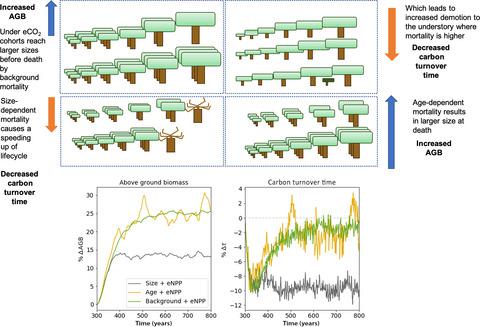当前位置:
X-MOL 学术
›
Glob. Change Biol.
›
论文详情
Our official English website, www.x-mol.net, welcomes your feedback! (Note: you will need to create a separate account there.)
Forest responses to simulated elevated CO2 under alternate hypotheses of size- and age-dependent mortality.
Global Change Biology ( IF 11.6 ) Pub Date : 2020-06-28 , DOI: 10.1111/gcb.15254 Jessica F Needham 1 , Jeffrey Chambers 1 , Rosie Fisher 2 , Ryan Knox 1 , Charles D Koven 1
Global Change Biology ( IF 11.6 ) Pub Date : 2020-06-28 , DOI: 10.1111/gcb.15254 Jessica F Needham 1 , Jeffrey Chambers 1 , Rosie Fisher 2 , Ryan Knox 1 , Charles D Koven 1
Affiliation

|
Elevated atmospheric carbon dioxide (eCO2) is predicted to increase growth rates of forest trees. The extent to which increased growth translates to changes in biomass is dependent on the turnover time of the carbon, and thus tree mortality rates. Size‐ or age‐dependent mortality combined with increased growth rates could result in either decreased carbon turnover from a speeding up of tree life cycles, or increased biomass from trees reaching larger sizes, respectively. However, most vegetation models currently lack any representation of size‐ or age‐dependent mortality and the effect of eCO2 on changes in biomass and carbon turnover times is thus a major source of uncertainty in predictions of future vegetation dynamics. Using a reduced‐complexity form of the vegetation demographic model the Functionally Assembled Terrestrial Ecosystem Simulator to simulate an idealised tropical forest, we find increases in biomass despite reductions in carbon turnover time in both size‐ and age‐dependent mortality scenarios in response to a hypothetical eCO2‐driven 25% increase in woody net primary productivity (wNPP). Carbon turnover times decreased by 9.6% in size‐dependent mortality scenarios due to a speeding up of tree life cycles, but also by 2.0% when mortality was age‐dependent, as larger crowns led to increased light competition. Increases in aboveground biomass (AGB) were much larger when mortality was age‐dependent (24.3%) compared with size‐dependent (13.4%) as trees reached larger sizes before death. In simulations with a constant background mortality rate, carbon turnover time decreased by 2.1% and AGB increased by 24.0%, however, absolute values of AGB and carbon turnover were higher than in either size‐ or age‐dependent mortality scenario. The extent to which AGB increases and carbon turnover decreases will thus depend on the mechanisms of large tree mortality: if increased size itself results in elevated mortality rates, then this could reduce by about half the increase in AGB relative to the increase in wNPP.
中文翻译:

在对大小和年龄依赖的死亡率的其他假设下,森林对模拟的二氧化碳升高的反应。
预计大气中二氧化碳(eCO 2)的升高会增加森林树木的生长速度。生长增长转化为生物量变化的程度取决于碳的周转时间,因此取决于树木的死亡率。大小或年龄相关的死亡率,再加上生长速度的增加,可能分别由于树木生命周期的加快而导致碳周转量减少,或者树木达到更大尺寸后生物量增加。但是,目前大多数植被模型都缺乏大小或年龄相关的死亡率以及eCO 2的影响的表示。因此,有关生物量和碳周转时间变化的信息是预测未来植被动态的不确定性的主要来源。通过使用功能复杂的陆地生态系统模拟器的植被人口统计学模型的复杂度降低形式来模拟理想化的热带森林,我们发现,尽管根据假设和假设,在大小和年龄相关的死亡情景中碳周转时间减少,生物量仍会增加生态2推动木本净初级生产力(wNPP)提高25%。由于树木生命周期的加快,在大小相关的死亡率情景中,碳周转时间减少了9.6%,而在死亡率与年龄相关的情况下,碳周转时间减少了2.0%,因为较大的树冠导致光竞争加剧。当死亡率取决于年龄时,地上生物量(AGB)的增加(24.3%)大于大小相关的(13.4%),因为树木在死亡前达到更大的大小。在背景死亡率恒定的模拟中,碳周转时间减少了2.1%,AGB增长了24.0%,但是,AGB和碳周转的绝对值高于与年龄或年龄相关的死亡率情景。因此,AGB增加和碳转换减少的程度将取决于大树死亡率的机制:
更新日期:2020-06-28
中文翻译:

在对大小和年龄依赖的死亡率的其他假设下,森林对模拟的二氧化碳升高的反应。
预计大气中二氧化碳(eCO 2)的升高会增加森林树木的生长速度。生长增长转化为生物量变化的程度取决于碳的周转时间,因此取决于树木的死亡率。大小或年龄相关的死亡率,再加上生长速度的增加,可能分别由于树木生命周期的加快而导致碳周转量减少,或者树木达到更大尺寸后生物量增加。但是,目前大多数植被模型都缺乏大小或年龄相关的死亡率以及eCO 2的影响的表示。因此,有关生物量和碳周转时间变化的信息是预测未来植被动态的不确定性的主要来源。通过使用功能复杂的陆地生态系统模拟器的植被人口统计学模型的复杂度降低形式来模拟理想化的热带森林,我们发现,尽管根据假设和假设,在大小和年龄相关的死亡情景中碳周转时间减少,生物量仍会增加生态2推动木本净初级生产力(wNPP)提高25%。由于树木生命周期的加快,在大小相关的死亡率情景中,碳周转时间减少了9.6%,而在死亡率与年龄相关的情况下,碳周转时间减少了2.0%,因为较大的树冠导致光竞争加剧。当死亡率取决于年龄时,地上生物量(AGB)的增加(24.3%)大于大小相关的(13.4%),因为树木在死亡前达到更大的大小。在背景死亡率恒定的模拟中,碳周转时间减少了2.1%,AGB增长了24.0%,但是,AGB和碳周转的绝对值高于与年龄或年龄相关的死亡率情景。因此,AGB增加和碳转换减少的程度将取决于大树死亡率的机制:


























 京公网安备 11010802027423号
京公网安备 11010802027423号